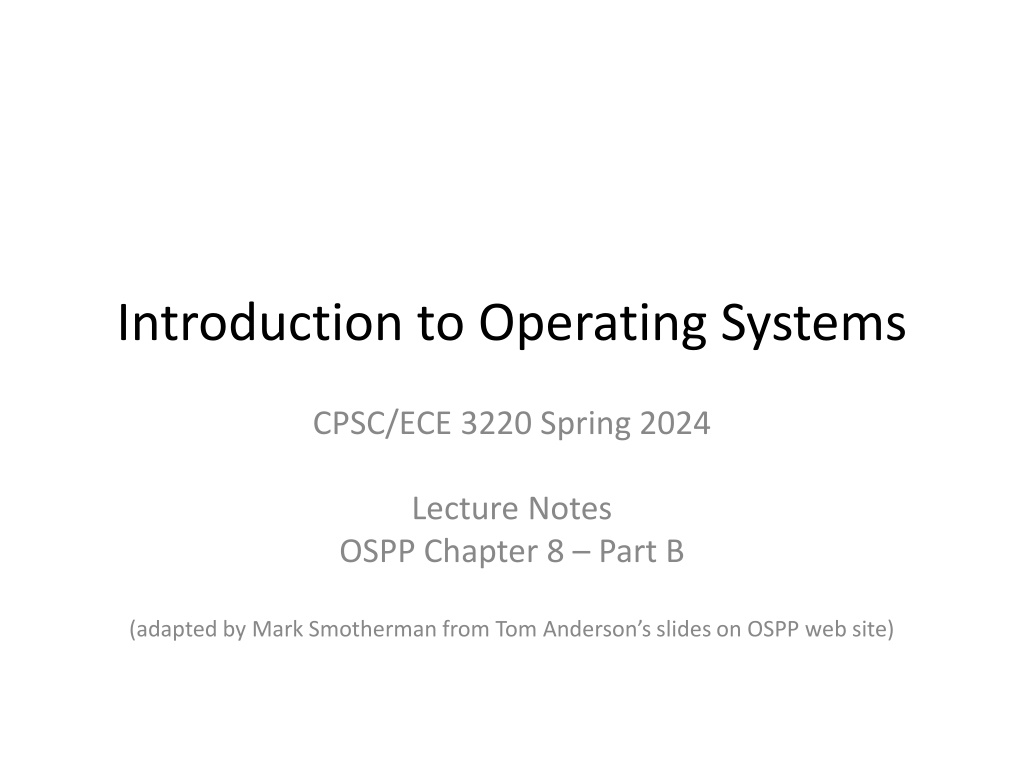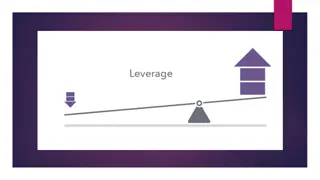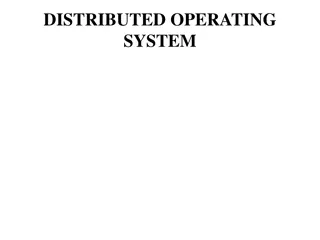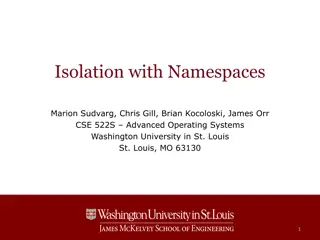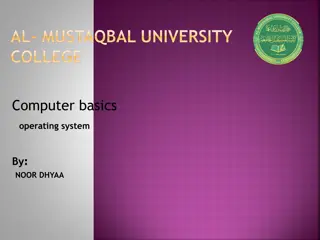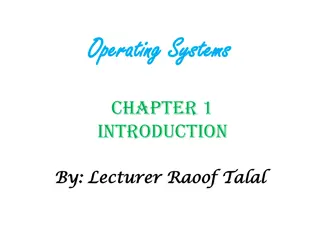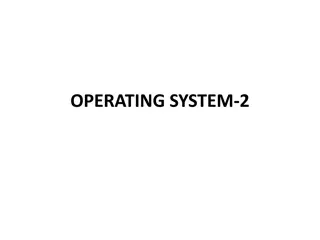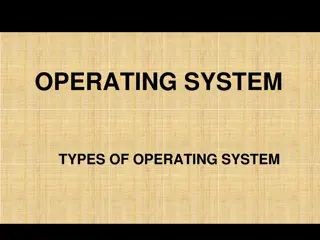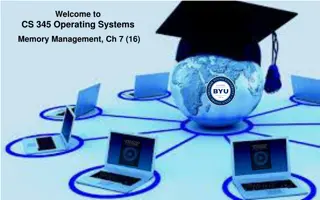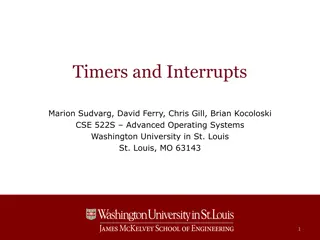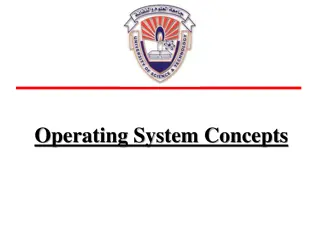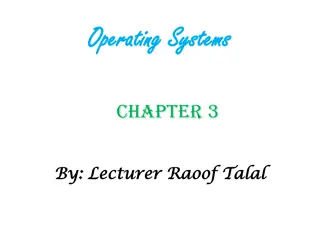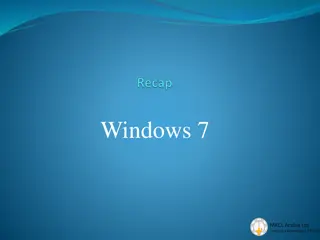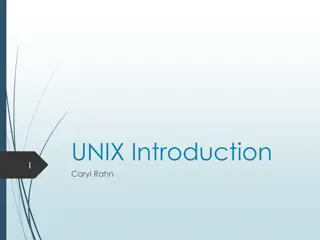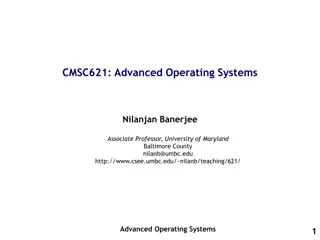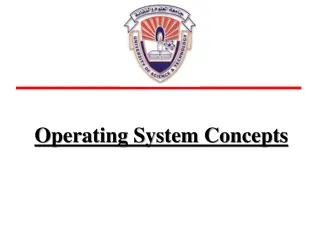Introduction to Operating Systems
Explore the concepts of address translation, Translation Lookaside Buffer (TLB), TLB usage in modern processors, TLB invalidate mechanisms, and hardware design principles related to memory hierarchy using examples from the Intel i7 processor. Understanding the trade-offs and costs associated with TLB misses and memory hierarchy design principles in operating systems.
Download Presentation

Please find below an Image/Link to download the presentation.
The content on the website is provided AS IS for your information and personal use only. It may not be sold, licensed, or shared on other websites without obtaining consent from the author. Download presentation by click this link. If you encounter any issues during the download, it is possible that the publisher has removed the file from their server.
E N D
Presentation Transcript
Introduction to Operating Systems CPSC/ECE 3220 Spring 2024 Lecture Notes OSPP Chapter 8 Part B (adapted by Mark Smotherman from Tom Anderson s slides on OSPP web site)
Efficient Address Translation Translation Lookaside Buffer (TLB) Cache of recent virtual page -> physical page translations Motorola calls it an address translation cache (ATC) If cache hit, use translation If cache miss, walk multi-level page table Cost of translation = Cost of TLB lookup + Prob(TLB miss) * cost of page table lookup
MIPS Software-Loaded TLB Most processors use hardware-defined translation tables and hardware-based table walks on TLB miss MIPS uses software-defined translation tables If translation is in TLB, ok If translation is not in TLB, trap to kernel Kernel computes translation and loads TLB Kernel can use whatever data structures it wants Pros/cons?
TLB Invalidate For a hardware-loaded TLB the OS kernel does not keep track what is in the TLB, and so it will issue a TLB invalidate instruction each time it removes a VPN-to-PFN mapping in a page table, whether the hardware TLB actually holds that VPN or not. A purge or flush typically means invalidating all the TLB entries.
Question What is the cost of a TLB miss on a modern processor? Cost of multi-level page table walk MIPS: plus cost of trap handler entry/exit
Hardware Design Principle The bigger the memory, the slower the memory
Memory Hierarchy i7 has 8MB as shared 3rd level cache; 2nd level cache is per-core
Question What is the cost of a first level TLB miss? Second-level TLB lookup What is the cost of a second level TLB miss? x86: 2-4 level page table walk How expensive is a 4-level page table walk on a modern processor?
Intel i7-1355U High-End Mobile (2023) Two performance cores Golden Cove cores 1.7 GHz base, 5 GHz turbo 2-way hyperthreaded Two levels of TLBs per core Caches per core: L1 i-cache: 32 KiB L1 d-cache: 48 KiB L2 cache: 1.25 MiB Eight efficiency cores Gracemont cores 1.2 GHz base, 3.7 GHz turbo Two levels of TLBs per core Caches per core: L1 i-cache: 64 KiB L1 d-cache: 32 KiB Cache per 4-core module: Shared L2 cache: 2 MiB Shared L3 cache: 12 MiB Up to 96 GB physical memory; 2-channel DDR4/LPDDR4/DDR5/LPDDR5 i7-1335U is about five times faster than i7-950 on CPUmark (take with a grain of salt)
When Do TLBs Work/Not Work? Video Frame Buffer: 32 bits x 1K x 1K = 4MiB
Superpages On many systems, TLB entry can be A page A superpage: a set of contiguous pages x86: superpage is set of pages in one page table x86 TLB entries 4KiB 2MiB 1GiB
When Do TLBs Work/Not Work (2) What happens when the OS changes the permissions on a page? For demand paging, copy on write, zero on reference, TLB may contain old translation OS must ask hardware to purge TLB entry On a multicore: TLB shootdown OS must ask each CPU to purge TLB entry
When Do TLBs Work/Not Work (3) What happens on a context switch? Reuse TLB? Discard TLB? Solution: Tagged TLB Each TLB entry has process ID TLB hit only if process ID matches current process
Address Translation Uses Process isolation Keep a process from touching anyone else s memory, or the kernel s Efficient interprocess communication Shared regions of memory between processes Shared code segments E.g., common libraries used by many different programs Program initialization Start running a program before it is entirely in memory Dynamic memory allocation Allocate and initialize stack/heap pages on demand
Address Translation Uses (2) Program debugging Data breakpoints when address is accessed Memory mapped files Access file data using load/store instructions Demand-paged virtual memory Illusion of near-infinite memory, backed by disk or memory on other machines Zero-copy I/O Directly from I/O device into/out of user memory Efficient support of virtual machines
Address Translation Uses (3) Checkpointing/restart Transparently save a copy of a process, without stopping the program while the save happens Persistent data structures Implement data structures that can survive system reboots Process migration Transparently move processes between machines Information flow control Track what data is being shared externally Distributed shared memory Illusion of memory that is shared between machines
Virtually Addressed vs. Physically Addressed Caches Too slow to first access TLB to find physical address, then look up address in the cache Instead, first level cache is virtually addressed In parallel, access TLB to generate physical address in case of a cache miss
Question With a virtual cache, what do we need to do on a context switch?
Aliasing Alias: two (or more) virtual cache entries that refer to the same physical memory A consequence of a tagged virtually addressed cache! A write to one copy needs to update all copies Typical solution Keep both virtual and physical address for each entry in virtually addressed cache Lookup virtually addressed cache and TLB in parallel Check if physical address from TLB matches multiple entries, and update/invalidate other copies
Dual-Tagged Cache (V and P) Figure from D. Culler, J. Singh, and A. Gupta, Parallel Computer Architecture
Multicore and Hyperthreading Modern CPU has several functional units Instruction decode Arithmetic/branch Floating point Instruction/data cache TLB Multicore: replicate functional units (i7-9xx: 4) Share second/third level cache, second level TLB Hyperthreading: logical processors that share functional units (i7-9xx: 2) Better functional unit utilization during memory stalls No difference from the OS/programmer perspective Except for performance, affinity,
